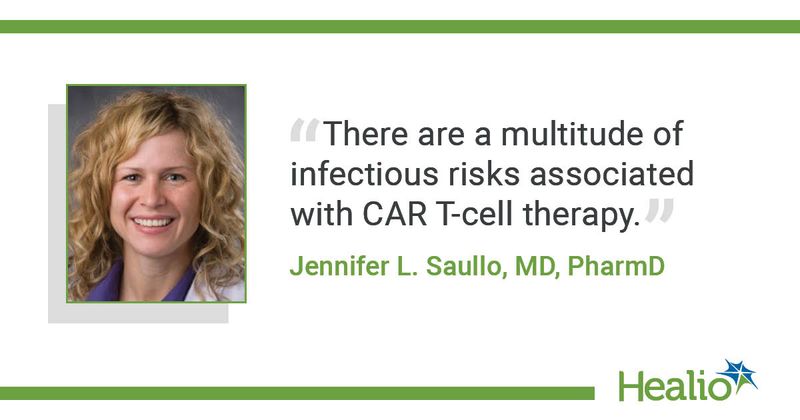Revaccination guidance after cell therapy established for some, ‘evolving’ for others
Guidelines on revaccination after cell therapy are clear for some patients but lack evidence-based consensus for others, according to an expert in infectious disease who spoke at NCCN 2022 Annual Congress: Hematologic Malignancies.
“Cell therapy recipients are at high risk for infectious complications, including vaccine-preventable diseases,” Jennifer L. Saullo, MD, PharmD, assistant professor of medicine in the division of infectious diseases at Duke University School of Medicine, told the audience. “Infection prevention measures — including vaccination — are paramount to improved morbidity and mortality.”

Revaccination of hematopoietic stem cell transplantation (HSCT) recipients is “essential” because immunity to vaccine-preventable disease “significantly wanes” after the procedure, according to Saullo.
Meanwhile less is known about the immune system’s reaction following chimeric antigen receptor T-cell therapy. Revaccination recommendations are “evolving” for CAR-T recipients, with preliminary evidence suggesting variable waning of protection against certain vaccine-preventable diseases, Saullo said.
Professional societies and organizations — including NCCN — provide recommendations on revaccination for vaccine-preventable diseases, COVID-19 and seasonal influenza, Saullo said, adding that clinicians should consider the following when contemplating revaccination after cell therapy:
- What is the goal for this vaccination?
- When should this vaccination be administered?
- Which vaccines are essential after cell therapy?
Saullo also emphasized that caregivers and close contacts of these patients need to maintain their vaccinations to limit the risk for infectious disease complications.
Revaccination after HSCT
More data is available on revaccination among HSCT recipients, Saullo noted. However, a “complex interplay of humoral and cell-mediated deficiencies,” along with a litany of other factors, cause fluctuations in immune reconstitution that lead to decreases in antibody titers for vaccine-preventable diseases, according to Saullo.
This, she added, requires multifaceted prophylactic interventions after HSCT, including antimicrobials, revaccinations and passive immunization.
“We are essentially recapitulating ontogeny in these patients — treating them as though we need to restimulate a naive immune system and vaccinate them akin to what we would do for a newborn child,” she told the audience. “This has been identified ... by the NIH as an area where there are lots of gaps in terms of our knowledge.”
Saullo advised consulting relevant professional guidelines on revaccination timelines, including those from American Society of Blood and Marrow Transplantation/European Society for Blood and Marrow Transplantation. All recommend a time-based approach that begins 3 to 6 months after HSCT.
Nevertheless, she questioned the wisdom of this approach “given all of the factors that impact or delay the recovery of T cells after [bone marrow transplant].”
Saullo instead advocated for an immune recovery-based approach to revaccination after HSCT. The factors include time since transplant, type of vaccine being used and laboratory/clinician criteria.
Essential vaccines after HSCT include Streptococcus pneumoniae; hepatitis A and B; herpes zoster; and measles, mumps and rubella (MMR).
Revaccination after CAR-T
Most of the emerging data on vaccination after CAR T-cell therapy relates to use of CD19-directed therapies to treat B-cell malignancies, such as B-cell acute lymphoblastic leukemia and diffuse large B-cell lymphoma, Saullo said.
“There are a multitude of infectious risks associated with CAR T-cell therapy, akin to what we have seen with hematopoietic stem cell transplant,” she noted. “Many of these are related to patient- or disease-specific characteristics, but some are associated with the use of CAR-T itself.”
Although the CAR-T process depletes the body of B cells, there is evidence that long-lived plasma cells that lack a CD19 receptor help a patient’s immune system maintain long-term, pathogen specific immune-protective memory after CAR T-cell therapy. Once such vaccine-preventable infectious disease is measles, for which limited preliminary data exist regarding stable virus-specific immunoglobin G levels after CAR-T, Saullo said.
Few data exist on the effect of B-cell maturation antigen-directed CAR-T, but results of one small study suggested that recipients are more likely to have increased susceptibility to vaccine-preventable infectious diseases compared with those who receive CD19-directed therapy, she added.
A schedule for revaccination of CAR-T recipients lacks consensus due to limited available data, Saullo said.
“Bottom line: there are no firm recommendations,” she told the audience. “There are some recommendations based on expert opinion, and this is an area where we will continue to see evolution in management. We may find that certain subsets may require a more robust post-CAR-T revaccination program.”

